In the ever-evolving landscape of digital marketing, PR link building will remain a topic of immense interest in 2024. This practice involves acquiring valuable backlinks from authoritative sources through strategic public relations efforts. It continues to be relevant due to Google’s evolving algorithms, which prioritize high-quality, natural backlinks as indicators of content authority.
Furthermore, as consumers become more discerning and demand credibility from brands, PR link building offers a means to establish trust through associations with reputable entities. In this article, we’ll delve into the world of PR link building, explore its techniques, and focus on leveraging press release publishing for high PR backlinks. Let’s unravel the power of digital PR, SEO, and press releases in our quest for link-building success.
What Is PR Link Building?
PR Link Building is a strategic digital marketing approach that combines public relations (PR) techniques with SEO to acquire high-quality editorial backlinks from authoritative websites. At its core, PR link building seeks to generate positive brand mention exposure and credibility by securing mentions, for example, in online publications, story ideas, blogs, and news outlets.
This SEO technique involves creating compelling and newsworthy content marketing, such as press releases, guest articles, or infographics, and then reaching out to journalists, bloggers, and industry influencers to promote this content. By leveraging content marketing and media relations, PR professionals aim to earn these valuable, high-quality links, which can significantly boost search engine rankings and organic traffic of sites.
PR link building operates in synergy with SEO, as acquiring natural backlinks from reputable sources and websites is a crucial ranking factor in search algorithms. Additionally, PR link building enhances PR digital marketing strategies by increasing brand visibility, driving referral traffic, and building trust with the target audience. It’s a multifaceted approach that not only elevates a website’s SEO performance but also strengthens its overall online presence, making it an integral part of any successful digital marketing campaign.
Importance in Modern SEO
Websites have to compete with hundreds, if not millions, of other similar sites. Search engines must evaluate each website’s quality and relevance to establish rankings. Figuring out which result is better is infinitely complex, and that’s why Google and other search engines rely on real-world endorsements from other sites.
For instance, if you have thousands of sites offering statistics, but only one site is earning backlinks from established news sites like the New York Times, Google will determine that the site must be offering the most credible or detailed information.
Consequently, it forms an opinion on which site to rank higher than the other. That’s the origin of domain authority, which is essentially a score that tries to measure how likely your site is to rank well in search engine results. Digital PR enhances the website’s chances of ranking as it contributes directly in terms of mentions and links.
Evolution of Digital PR and SEO
PR emerged as a profession in the early 20th century, when industrialization created a need for organizations to shape their public image and reputation.
With the advent of the internet and digital technologies, PR practitioners began distributing content directly to the public.
The synergy between digital PR and SEO emerged after brands realized the indirect benefits of having their messages picked up by other publications and, in the process, earning backlinks and mentions that increased their authority in the search engine’s eyes.
Another noteworthy milestone has been the emergence of influencer marketing in the 2010s, which has allowed brands to leverage the power and credibility of online personalities and celebrities to shape their public’s perception.
Transition from Traditional Press Links to Digital PR SEO
The transition from traditional PR meaning in text press links to digital PR SEO represents a seismic shift in the world of public relations and marketing. Traditional PR relied heavily on a press release, media coverage, and event promotions to build brand reputation and convey messages. Its goals were primarily centered around securing favorable mentions, like in a press release, in established media outlets and reaching a limited, albeit influential, audience.
In contrast, digital PR leverages online platforms, social media, and digital content to achieve its objectives. A digital PR strategy focuses on creating engaging, shareable PR content that not only appeals to journalists but also resonates with a broader online audience. The primary goal of digital PR is to extend brand visibility, enhance its search engine rankings, get better positions on search engine results pages, and foster a more extensive and engaged online community.
This shift has democratized PR, enabling brands to connect directly with their target audience without relying solely on traditional media gatekeepers. The real-time nature of digital PR real-time nature allows for quick responses to trends and issues, and its metrics-driven approach enables data-driven decision-making. In essence, digital PR and SEO have expanded the reach and impact of PR efforts by harnessing the power of the digital landscape and the interconnectedness of today’s online audience.
Rise of Reactive Digital PR Link Building
While traditional PR is often planned and scheduled in advance, a reactive PR link building strategy involves responding to current events, trends, or news stories in a way that promotes a brand, product, or service. For instance, countless brands have taken advantage of viral TikTok trends. Amazon now features TikTok-viral products as a separate category.
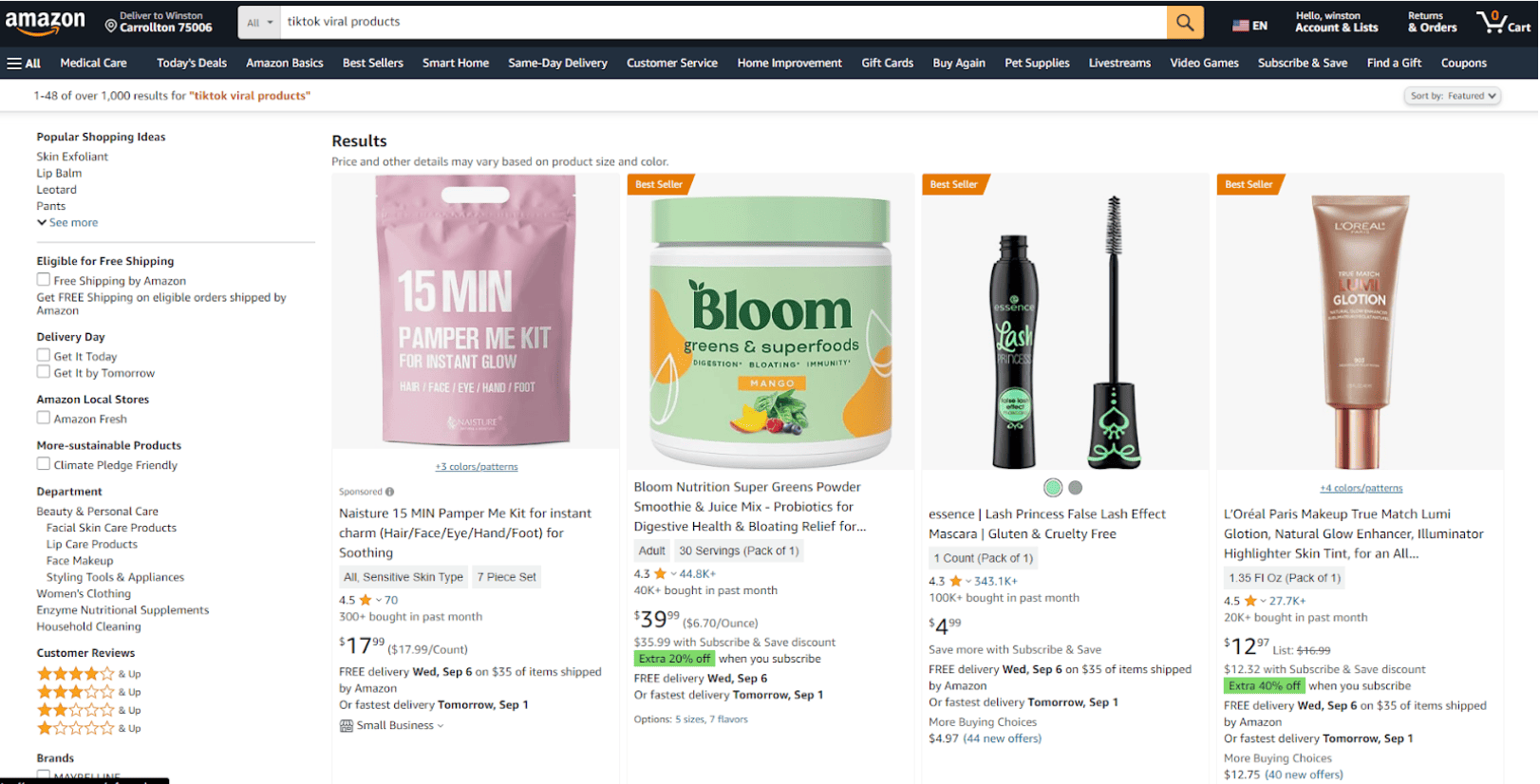
The Amazon product page continues to accrue relevant links from blogs writing about must-have viral products, as this example shows:
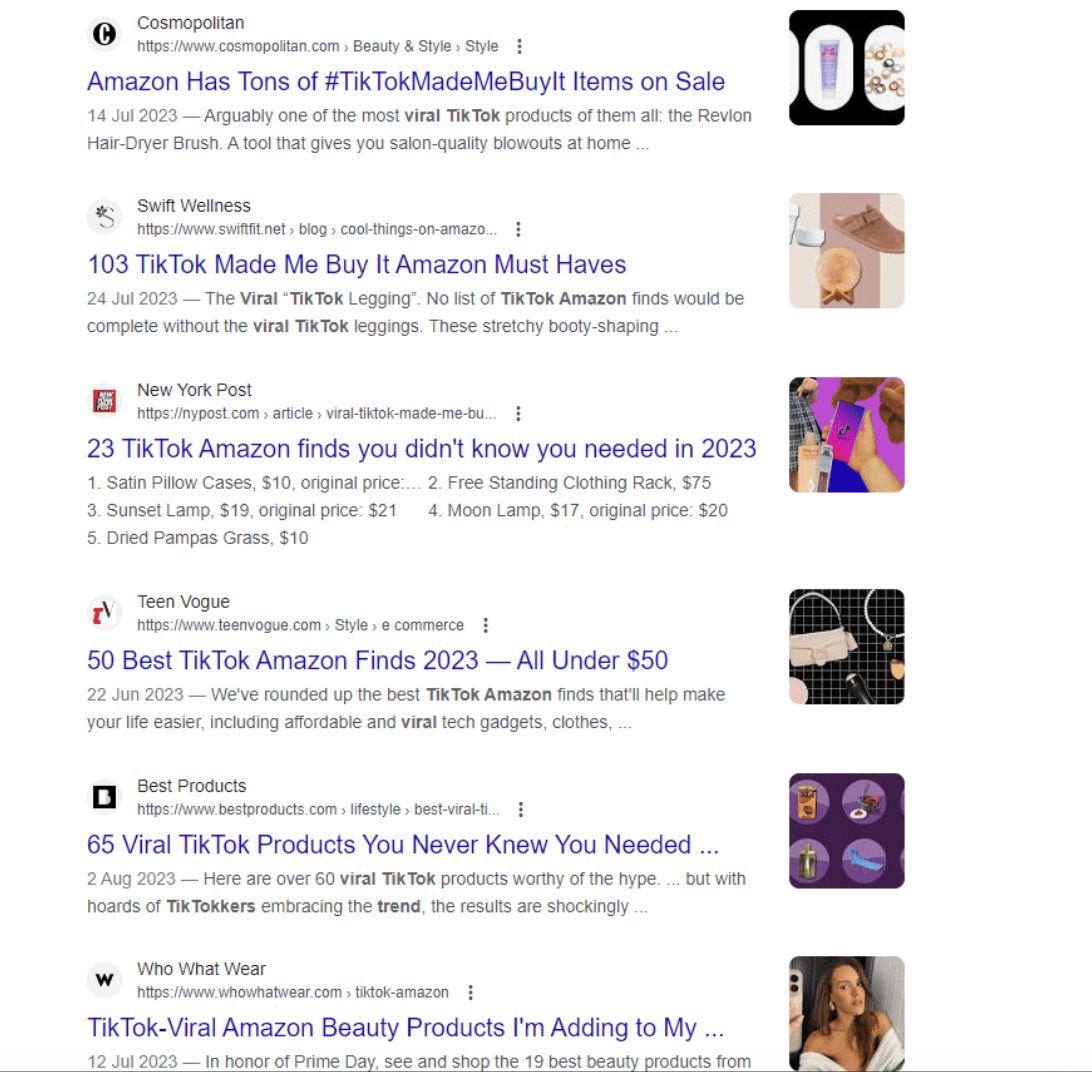
Why are brands trending towards reactive content? It creates a sense of urgency and relevance for the audience, which is more likely to engage with timely and topical content.
There are higher chances of getting media attention and coverage, as journalists and influencers are always looking for fresh and interesting angles. Reactive content can potentially go viral, generating more shares and traffic.
Crafting a Successful PR Link Building Campaign
What is a link building campaign? It’s the coordinated process of increasing the number of high PR links from other sites. To succeed in digital PR, you need a strategic plan that aligns with your goals and targets the right audience. It’s important to research your industry and competitors to identify publications, trending topics, and gaps that exist in the current content landscape.
Pitching high-quality content to the right outlets and contacts is another part of crafting a successful PR link building campaign. You’ll need a list of potential journalists to contact, and the content you pitch must be relevant to their beat (area of specialization).
There will be a need to set guidelines on how you’ll create high quality content that sparks interest. Additionally, you should plan how to track and measure your results.
Understanding Your Audience
Understanding your audience is paramount to effective communication. Conduct thorough audience research to create audience personas, which are detailed profiles representing your target audience segments. Identify their pain points, challenges, and desires to tailor your content marketing accordingly.
By addressing specific audience needs and preferences, you can create content that resonates and engages with your audience on a deeper level, fostering stronger connections and driving desired outcomes. Don’t underestimate the power of knowing your audience—it’s the key to successful communication strategies.
Data-Backed Content Creation
Data-based content creation is a powerful PR SEO strategy that can help establish credibility and trust with your audience, as well as attract more attention and engagement. For instance, the following data-backed article from the Pew Research Center has received over 12,000 backlinks.
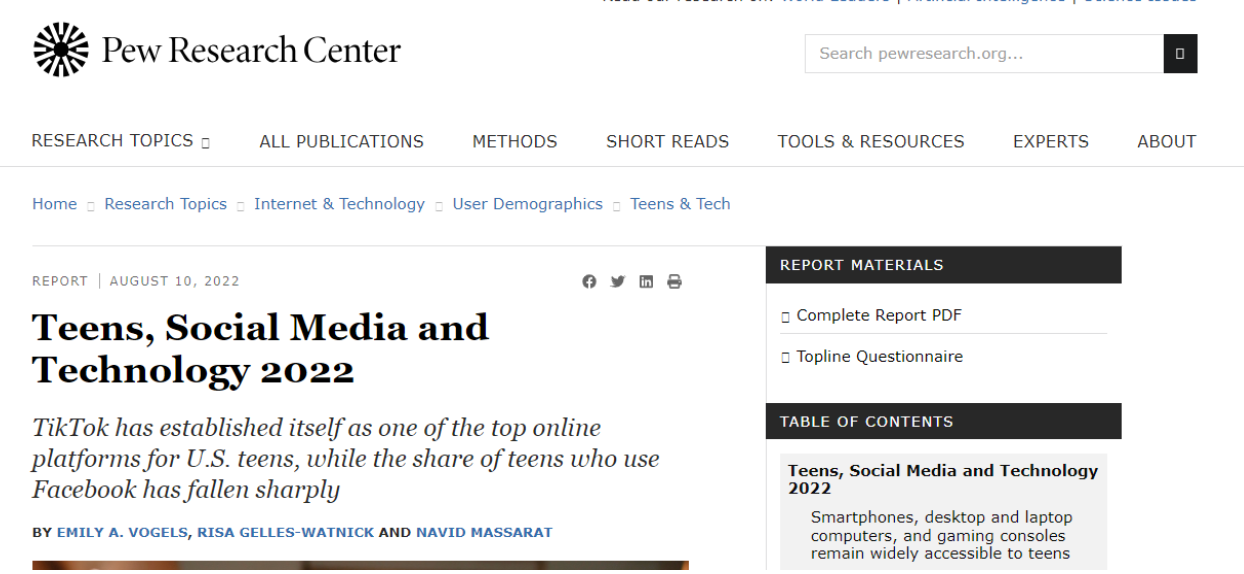
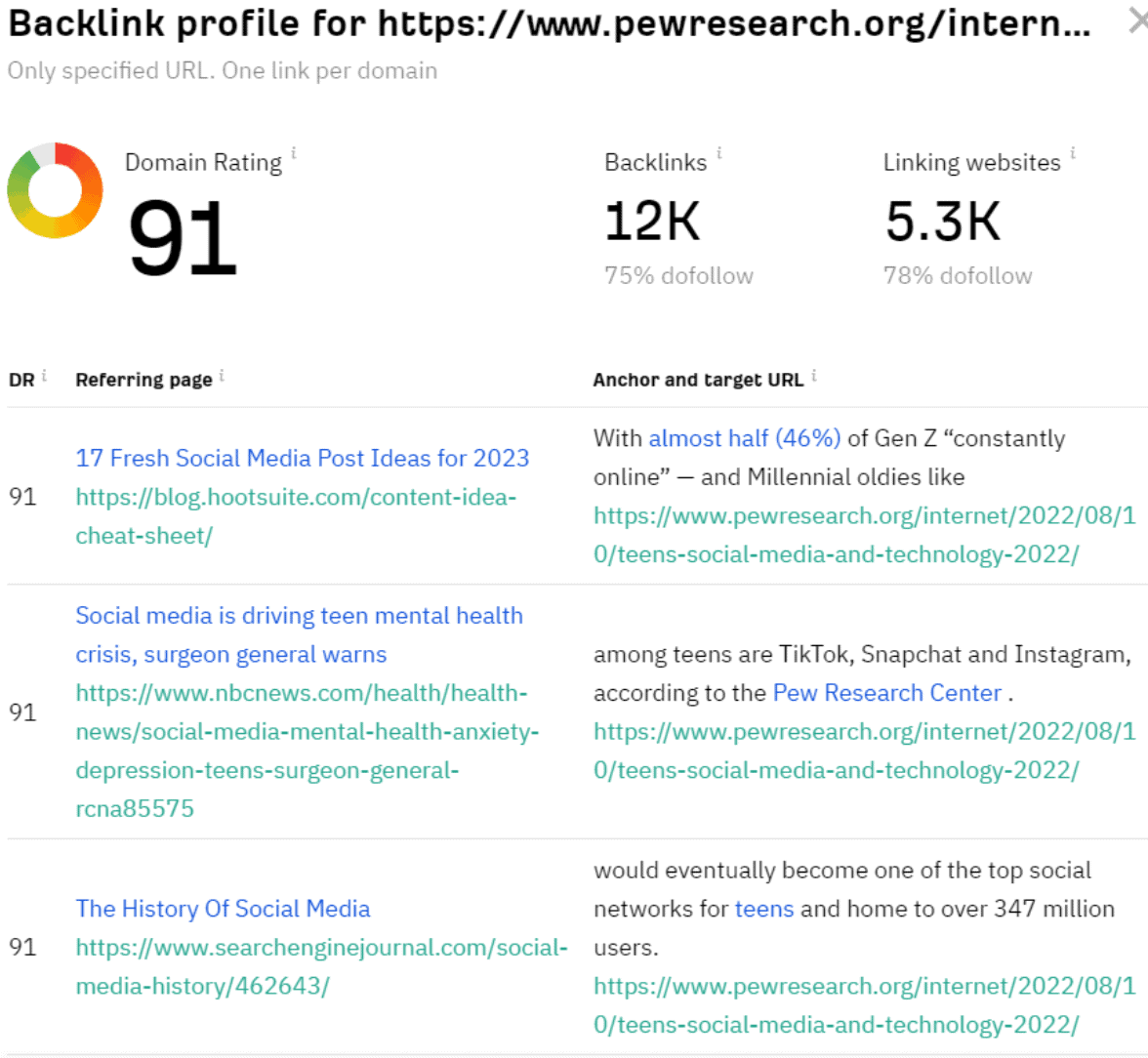
Most of the referring pages are high-quality domains, including:
- Hootsuite.com (91 Domain ratings with 11M backlinks)
- Nbcnews.com (91 Domain rating with 28 M backlinks)
- Searchenginejournal (91 Domain rating with 4.5 million backlinks)
You can create data-backed content by:
- Sourcing reliable data from reputable sources as well as proprietary company data or self-sponsored surveys.
- Integrating data into your content narrative and using it to tell a story that captures attention.
- Fostering transparency in data presentation, for instance, by giving context to how you collected, analyzed, and interpreted the data.
Visual Components in PR
Visual components are essential for creating content as they easily capture the attention of readers and convey information more effectively with better retention rates. Some of the most common types of visual components are infographics, images, and videos.
Infographics are more suitable for sharing complex data or actionable tips. When you use them for this digital activity, make them easily embeddable.
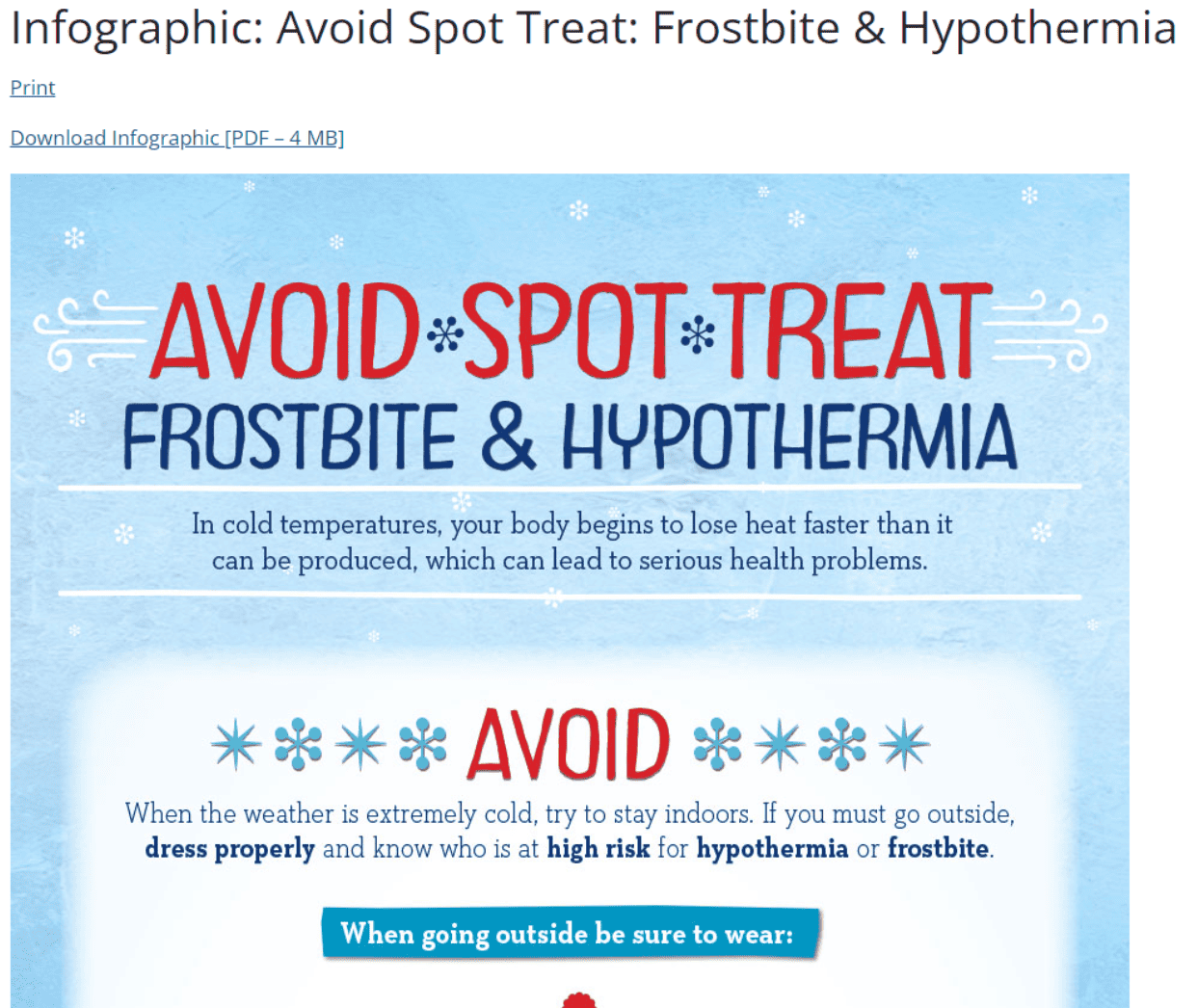
Source: cdc.gov
Based on its backlink analysis, the infographic has been popular with health sites:
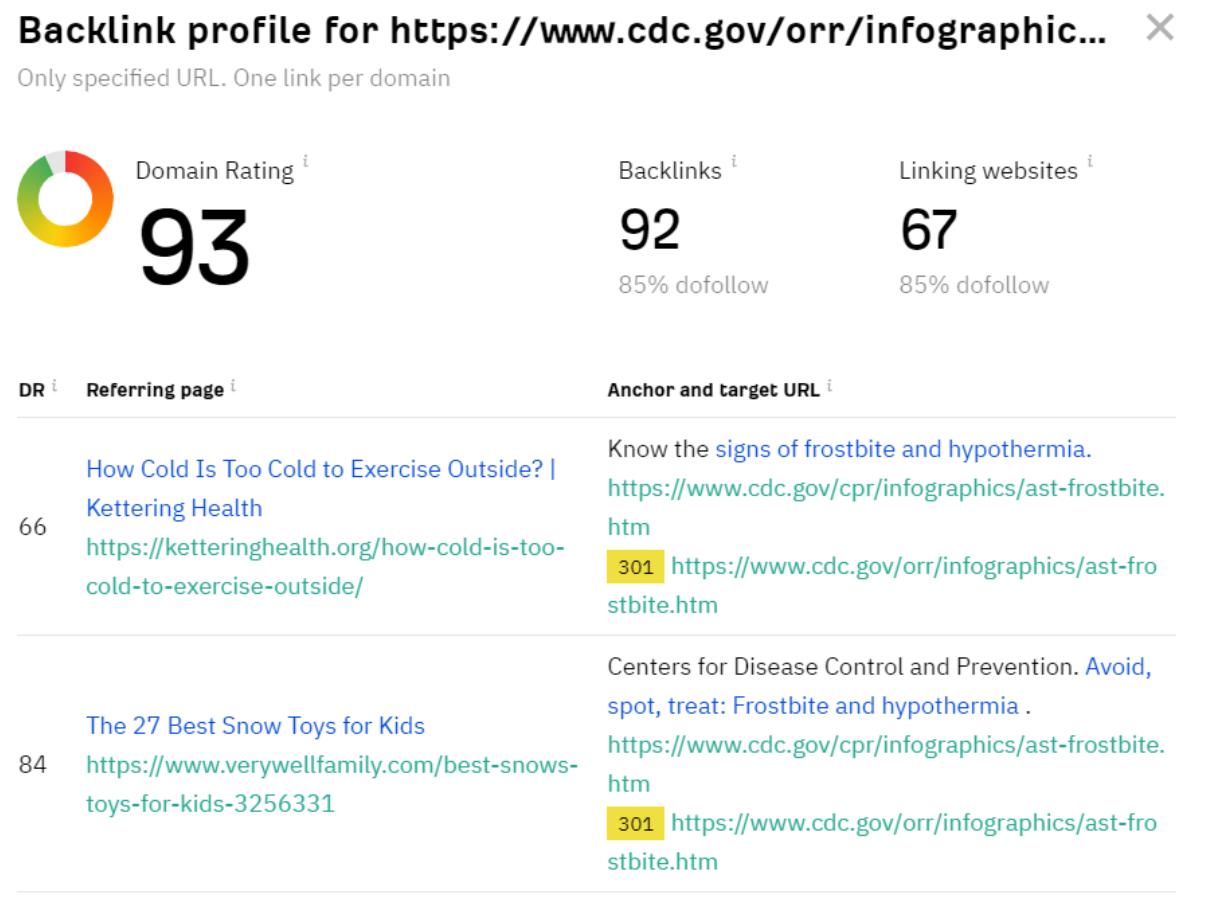
Note that infographics have had their time and may not be suitable for all situations. For instance, Airbnb chose to use the video format when they launched a PR campaign in 2021:
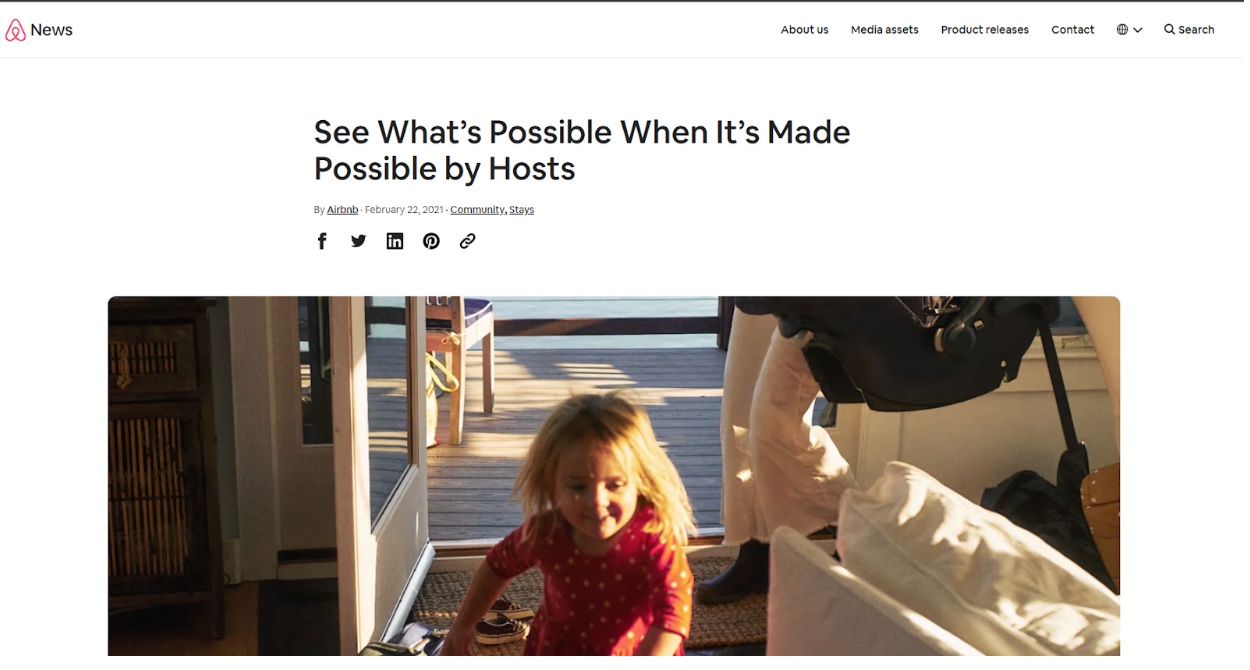
The campaign was more targeted at travel websites than data analysts, and this was reflected in the press release backlinks they earned.
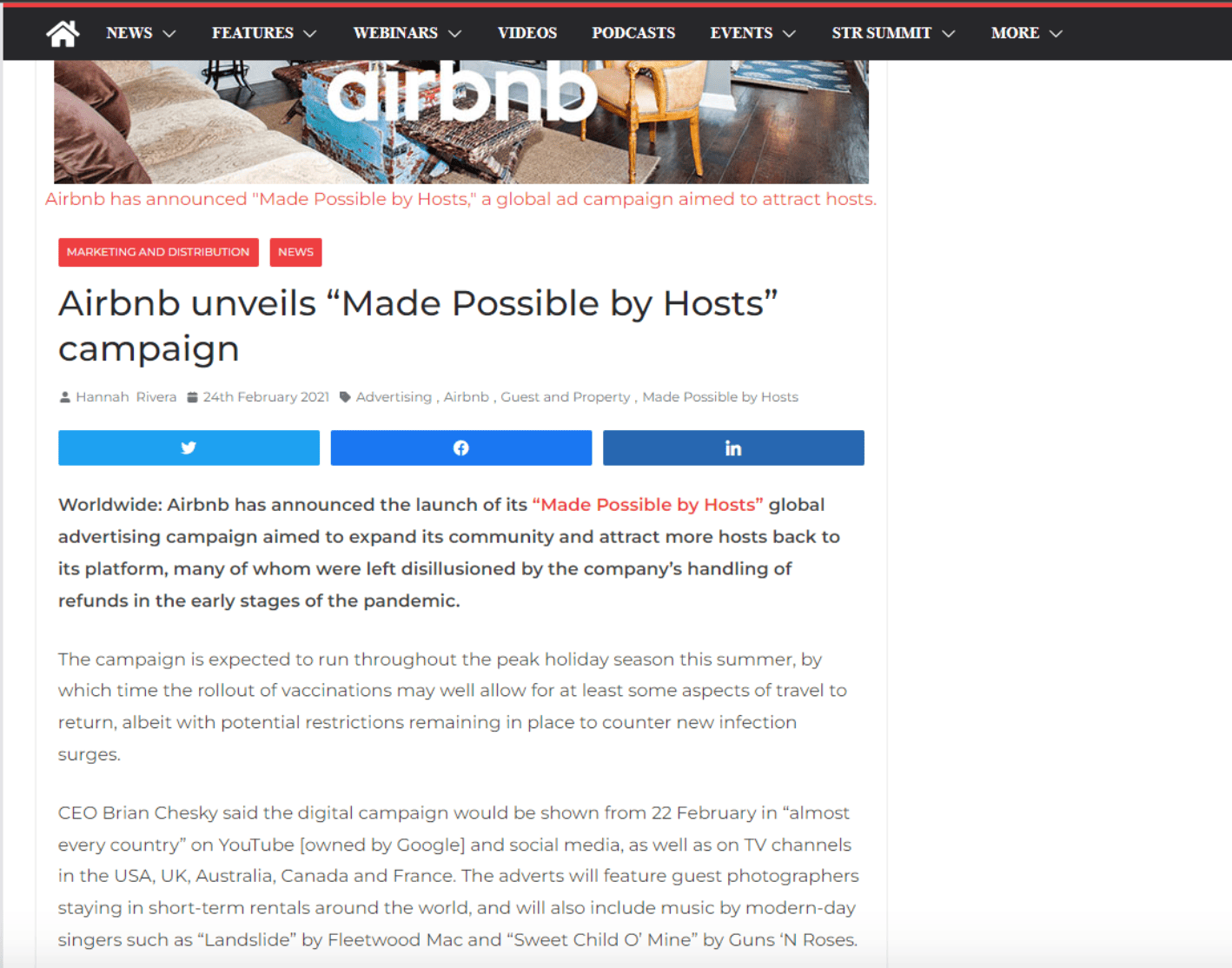
Images, infographics, and videos are crucial for engaging content. They grab attention, aid understanding, and boost engagement. Research the visuals your audience and publications prefer.
Reactive Digital PR: Seizing High PR Link Opportunities
Reactive PR involves responding to events, trends, news articles, or opportunities that are relevant to your business in order to gain media attention and links. For example, if you are a local tour group, you can react to a viral new report on the “Best places to live in 2024” by publishing a guide on the hiking routes in the popular places to live in 2024.
The article may include photos from actual trails, entry fees, etc. Local news outlets and other sites in the travel industry might end up picking this up.
Reactive PR will help you build relationships with journalists, increase your popularity, and boost your SEO efforts. However, it may mandate constant monitoring of the media landscape and acting quickly when an opportunity arises.
You may also find it too competitive if you’re in a crowded niche. There are no assurances or controls over how the news story is received or presented, making it unpredictable and risky.
Some of the best practices to win at reactive digital PR entail:
- Covering topics that align with your business objectives and audience interests;
- Evaluating if a particular trend is worthwhile and not too lived as the buzz may move on too quickly;
- Evaluating if you’re best poised to respond based on your current knowledge, expertise, and resources.
What Is a PR Link in the Context of Reactive Digital PR?
What is a PR link? In the context of Reactive Digital PR, a PR link refers to a backlink or hyperlink that a site or online publication provides to another site in response to a story or piece of content that has already been published.
These links are typically earned through the proactive efforts of a PR team or individual to monitor and engage with online conversations, news articles, blog posts, or social media discussions that mention their brand, products, or industry. The goal of securing PR links is to enhance a website’s search engine optimization (SEO), credibility, and online visibility.
PR links are obtained reactively, meaning they are acquired in response to existing online content or conversations. This requires monitoring online mentions, for example, in a story, and being quick to respond.
PR links differ from proactive PR in terms of timing and approach. PR is the most effective in scenarios where brands can leverage existing online discussions or situations to their advantage.
Tips for Securing High PR Backlinks
Here are some pointers that reveal how to get high pr backlinks:
- Monitor social media posts and news sources in real time. Consider tracking relevant keywords, topics, or brand mentions using tools like Google Alerts, Twitter, or BuzzSumo.
- Shortlist your target media outlets and contacts in advance.
- Produce original and expert-led content that’s highly factual and impactful as soon as you spot a new opportunity. You may have up to 24 hours or several weeks to respond in some cases.
- Craft a compelling pitch that highlights your unique angle, value proposition, or expertise on the topic.
- Follow up with your contacts.
- Monitor the performance of your campaign using metrics like traffic, engagement, shares, and backlinks.
Remember that the key to securing high PR backlinks is not just about the quantity but also the quality of the links. In your content marketing strategy, always prioritize providing valuable, relevant, and timely content that adds unique insights to existing news narratives.
Digital PR Outreach: Building Relationships
Outreach is both an art and a science in the digital PR world. Remember that no one is waiting to do your bidding. And in most cases, journalists are pretty inundated and overloaded with requests. For instance, journalists and editors on sites with a domain authority of 90+ receive up to 32 pitches per day.
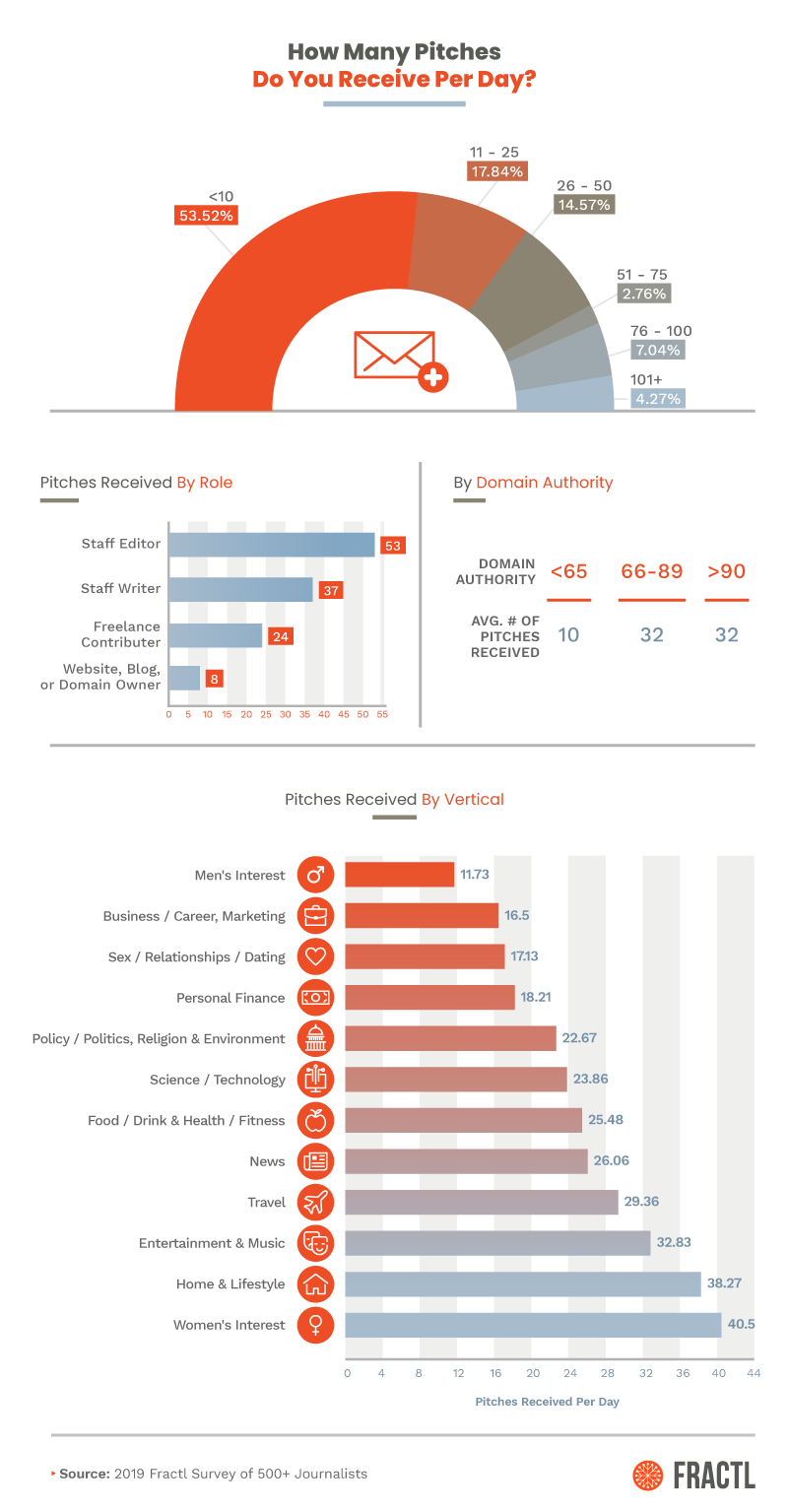
Source: Fractl
You must have something worthwhile to offer when reaching out to journalists – and that doesn’t mean handing them money. That would be unethical and might damage your reputation.
Instead, you can offer them exclusive access, industry expert insights, original data/story, or valuable resources that can enhance their work. The relationships you build and maintain will come in handy in other scenarios, such as getting feedback, finding opportunities, or collaborating on projects.
Effective Outreach Techniques
Here are some techniques that can help you improve your outreach success:
- Personalize your communications: Avoid sending generic emails to a large list. Instead, tailor your messages to each recipient, addressing them by name, mentioning something relevant to their work or interests, and explaining why you are reaching out to them specifically.
- Leverage social media for outreach: Utilize social media services to research your prospects and engage with their content.
- Use PR tools to streamline processes: Services such as BuzzStream or Pitchbox will automate and optimize your outreach efforts, for instance, by helping you find contacts and personalize emails. HARO or Qwoted can help you connect with journalists looking for sources.
- Follow-up: Most of the time, you’ll not get a response from your first outreach attempt due to many factors. Following up within a reasonable period of time, usually between 2 and 7 days, can boost your response rate.
Maintaining Relevance and Authority
Outreach must be done with care and integrity to ensure that you pick placements that align with your brand’s values and mission and not ones that compromise its reputation or credibility. For instance, you may land in trouble by only earning placements on spammy sites such as link farms.
To ensure that outreach is effective and ethical, vet potential outreach targets for topical relevance and authority. This means researching their target audience and content. You also need to use SEO tools that can inform you about the website’s authority. But don’t consider the strength of the site’s SEO metrics alone.
Measuring the Success of a PR Link Building Campaign
To justify your investment in high PR link building, you actually need to track the results you get versus what you have spent. There are various key performance indicators you need to track as part of the analytics side of PR link building:
- Number and quality of PR backlinks;
- Referral traffic and conversions;
- Presence of valuable links from high domain authority sites;
- Number of press and brand mentions;
- Relevance of the linking sites to your niche and audience;
- Improvements to keyword search rankings.
Data-driven decision-making and ongoing optimization are crucial for a successful link building campaign. If, after three PR campaigns and significant content investment, you haven’t acquired any backlinks and have the same results, it’s wise to scale back or explore alternative PR strategies. Consistent outcomes suggest a need for change.
Key Metrics to Consider
When it boils down to whether the PR link building campaign was effective, you need to pay attention to the following key metrics:
- Backlink quality: It’s impacted by the relevance, authority, and trustworthiness of the websites that link to your site. High quality links come from sites with high domain authority, low spam scores, and similar audience bases & topics;
- Referral traffic: In cases where you acquire nofollow links, tracking referral traffic is essential. Even though these links may not directly impact SEO, they can still drive valuable visitors to your site and PR link content, contributing to your overall web presence and user engagement.
- Domain authority: You can track your DA score at the start of the campaign and after an interval of several months to see if the new high quality links have positively impacted it. Tracking the Domain Authority of referring domains is vital, as quality backlinks from high-value domains can enhance your site’s DA over time.
- Additional metrics: Depending on your goals and strategy, you may also want to consider social media shares, conversions, leads, sales, revenue, etc.
All the metrics will help reveal how your PR link building campaign is contributing to your overall business objectives and ROI.
Value of High PR Backlinks and Press Release Links
Not all backlinks are equal; for example, UGC links vs. editorial links. Some backlinks have a positive impact on your ranking, while others can have a negative or even harmful effect. Some of the factors that determine how much value and traffic you get from PR backlinks include:
- Authority: High authority backlinks from high DA sites pass more link equity.
- Relevance: Endorsements from related websites carry more weight. It’s akin to a doctor receiving recommendations from other doctors, not just patients.
- Link context: A link placed editorially and with proper context about what users should expect when they click on the link can drive more traffic, and it also tells Google what the page contains.
- Anchor text: The anchor text can optimize the page for certain keywords, but overusing exact-match anchor text can come off as spammy.
Not all backlinks are equal, and high quality backlinks, including high PR backlinks and well-optimized press release links, offer significant SEO benefits. They improve search engine rankings, enhance credibility, and drive organic traffic. Conversely, low-quality backlinks can harm your website’s reputation and SEO efforts. It’s crucial to focus on building a diverse portfolio of high-quality backlinks to achieve long-term SEO success.
Future of PR Link Building
As technology advances, new tools and platforms will emerge that will enable PR professionals to reach out to potential link coming sources more efficiently. Google and other search engine algorithms will become better at providing the best user experience and, in so doing, will become more adept at detecting manipulative link building practices, including follow links. This could influence sites looking for press link opportunities from low-domain sources or participating in paid PR linking schemes.
Industry trends will influence the success of PR link building campaigns. Adept practitioners will jump on trends such as hosting online events, working with influencers, using AI services, or leveraging the power of big data for insights into their target audience’s behavior and preferences for better traffic.
Role of AI in PR Link Building
AI has the potential to transform the link building process, making it more efficient and effective. Some of the possible applications of AI in PR link building are:
- Predictive analytics: Predictive analytics powered by AI can help PR professionals identify emerging trends and topics within their industry, enabling them to proactively target and build links from authoritative sources, ultimately boosting their topical authority in the online space;
- Automated outreach: AI will help automate the outreach process, using natural language generation and personalization to craft engaging and customized messages;
- AI-driven content creation: PR practitioners will leverage AI to create high-quality and relevant content, not user generated, much faster and cheaper than before.
Despite the advances brought by AI, there will be challenges and ethical issues for PR link building, such as data privacy, transparency, accountability, and human oversight.
Predictions for 2024
Based on current trends and industry insights, here are some predictions for PR links in 2024:
- There will be an increasing shift towards strategic and data-driven campaigns, focusing on quality over quantity and relevance over popularity.
- PR practitioners will rely more on influencer marketing, social media, and content creation as traditional media outlets lose their grip on market share.
- The implementation of artificial intelligence will lead to more discussions about its drawbacks and opportunities.
- Consumers and regulators will demand more accountability and authenticity from brands.
Conclusion: The Power of PR Links and Digital PR SEO
Digital PR is one of the most reliable ways to earn links from authoritative and trustworthy sources. But it requires brands to produce new and engaging content, such as press releases and new research reports, around topics of interest. For success, brands will need to understand their target audience, produce data-backed content, reach out to the right people, and incorporate visuals, among other practices.
They will also need to pay attention to the opportunities offered by reactive PR, which can allow them to capitalize on already trending topics while saving their resources. As one of the most ethical ways to build links, Digital PR will remain an essential part of SEO in the modern digital landscape for the foreseeable future.
So, if you need help with digital PR link building, you can get help from SEO agencies such as Backlinkers. Contact us for any inquiries or clarifications on all matters SEO!






